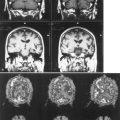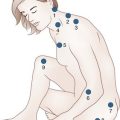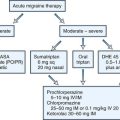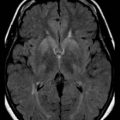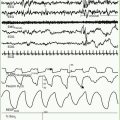Chapter 3 Falls and Drop Attacks
Everyone occasionally loses balance and sometimes falls, but repeated and unprovoked falls signal a potentially serious neurological problem. Considering the large number of potential etiologies, it is helpful to determine whether a patient has suffered a drop attack or an accidental fall. The term drop attack describes a sudden fall occurring without warning that may or may not be associated with loss of consciousness. Falls, on the other hand, reflect an inability to remain upright during a postural challenge. This most commonly affects individuals with chronic neurological impairment. When associated with loss of consciousness, drop attacks are likely due to a syncopal or epileptic event. Patients with preserved consciousness during a drop attack may harbor midline tumors in the third ventricle or in the posterior fossa. Transient ischemic attacks (TIAs) involving the posterior circulation or the anterior cerebral artery distribution can manifest in the same monosymptomatic manner. Narcoleptics experience cataplexy, and patients with Meniere disease may fall abruptly as a result of otolith dysfunction. Patients with lower-extremity weakness, spasticity, rigidity, sensory loss, or ataxia frequently fall. Middle-aged women may fall with no discernible cause. Finally, the elderly, with their inevitable infirmities, fall frequently and with potentially disastrous consequences. These associations permit a classification of falls and drop attacks, presented in Box 3.1.
 Has the patient fallen before?
Has the patient fallen before?
 Did the patient lose consciousness? If so, for how long?
Did the patient lose consciousness? If so, for how long?
 Did lightheadedness or palpitations precede the event?
Did lightheadedness or palpitations precede the event?
 Is there a history of a seizure disorder, startle sensitivity, or of falls precipitated by strong emotions?
Is there a history of a seizure disorder, startle sensitivity, or of falls precipitated by strong emotions?
 Has the patient had excessive daytime sleepiness?
Has the patient had excessive daytime sleepiness?
 Does the patient have headaches or migraine attacks associated with weakness?
Does the patient have headaches or migraine attacks associated with weakness?
 Does the patient have vascular risk factors, and were there previous symptoms suggestive of TIAs?
Does the patient have vascular risk factors, and were there previous symptoms suggestive of TIAs?
 Are there symptoms of sensory loss, limb weakness, or stiffness?
Are there symptoms of sensory loss, limb weakness, or stiffness?
 Is there a history of visual impairment, hearing loss, vertigo, or tinnitus?
Is there a history of visual impairment, hearing loss, vertigo, or tinnitus?
Loss of Consciousness
Syncope
The manifestations and causes of syncope are described in Chapter 2. Severe ventricular arrhythmias and hypotension lead to cephalic ischemia and falling. With sudden-onset third-degree heart block (Stokes-Adams attack), the patient loses consciousness and falls without warning. Less severe causes of decreased cardiac output, such as bradyarrhythmias or tachyarrhythmias, are associated with a prodromal sensation of faintness before the loss of consciousness. Elderly patients with cardioinhibitory sinus syndrome (“sick sinus syndrome”), however, often describe dizziness and falling rather than faintness, because of amnesia for the syncopal event. Thus, the history alone may not reveal the cardiovascular etiology of the fall. By contrast, cerebral hypoperfusion due to peripheral loss of vascular tone usually is associated with a presyncopal syndrome of progressive lightheadedness, faintness, dimming of vision, and “rubbery”-feeling legs. But even in the context of positive tilt table testing, up to 37% of patients report a clinically misleading symptom of true vertigo (Newman-Toker et al., 2008). So-called “cardiogenic vertigo” and downbeat nystagmus may also occur with asystole (Choi et al., 2010).
Orthostatic hypotension conveys a markedly increased risk of falling in the elderly and is particularly problematic in frail persons with additional risk factors for falling (Mussi et al., 2009) (see “Aged State” later in this chapter). Sudden drops in young persons, particularly when engaged in athletic activities, suggest a cardiac etiology. Exertional syncope requires a detailed cardiac evaluation to rule out valvular disease, right ventricular dysplasia, and other cardiomyopathies.
Seizures
In children and adolescents with a history of drop attacks, a tilt-table test should be considered to avoid overdiagnosing epilepsy (Sabri et al., 2006). True epileptic drop attacks in young patients with severe childhood epilepsies may respond favorably to callosotomy (Sunaga, Shimizu, and Sugano, 2009). Falling as a consequence of the tonic axial component of startle-induced seizures may be controllable with lamotrigine. Paradoxically, some antiseizure drugs can precipitate drop attacks, such as carbamazepine in rolandic epilepsy.
Transient Ischemic Attacks
Anterior Cerebral Artery Ischemia
Anterior cerebral artery ischemia causes drop attacks by impairing perfusion of the parasagittal premotor and motor cortex controlling the lower extremities. Origination of both anterior cerebral arteries from the same root occurs in approximately 20% of the population and predisposes to ischemic drop attacks from a single embolus. Paraparesis and even tetraparesis can result from simultaneous infarctions in bilateral ACA territories (Kang and Kim, 2008).
Third Ventricular and Posterior Fossa Tumors
Drop attacks can be a manifestation of colloid cysts of the third ventricle, Chiari malformation (“Chiari drop attack”), or mass lesions within the posterior fossa. With colloid cysts, unprovoked falling is the second most common symptom, after position-induced headaches. This history may be the only clinical clue to the diagnosis because the neurological examination can be entirely normal. Abrupt neck flexion may precipitate drop attacks in otherwise asymptomatic patients who are harboring posterior fossa tumors. Drop attacks occur in 2% to 3% of patients with Chiari malformation. These may be associated with loss of consciousness and often resolve after decompression surgery (Straus et al., 2009). Drops induced by rapid head turning were considered pathognomonic of cysticercosis of the fourth ventricle in the early 20th century (Brun sign). Other intracranial mass lesions such as parasagittal meningiomas, foramen magnum tumors, or subdural hematomas can also be associated with sudden drops. However, baseline abnormalities of gait and motor functions coexist, and falling may occur consequent to these impairments rather than to acute loss of muscle tone.
Otolithic Crisis
During attacks of vertigo, patients often lose balance and fall. Meniere disease (see Chapter 37) may be complicated by “vestibular drop attacks” unassociated with preceding or accompanying vertigo (Tumarkin otolithic crisis) in approximately 6% of patients. Presumably, stimulation of otolithic receptors in the saccule triggers inappropriate postural reflex adjustments via vestibulospinal pathways, leading to the falls. Affected patients report feeling as if, without warning, they are being thrown to the ground. They may fall straight down or be propelled in any direction. Indeed, one of the authors had a patient who reported suddenly seeing and feeling her legs moving forward in front of her as she did a spontaneous back-flip secondary to an otolithic crisis. Vestibular drop attacks may also occur in elderly patients with unilateral vestibulopathies who do not satisfy diagnostic criteria for Meniere disease (Lee et al., 2005).
Disorders of the Basal Ganglia
Parkinson Disease
Patients with PD fall with a frequency of 81% over the long term and suffer twice as many fractures compared to age-matched controls. The forward-flexed posture, muscular rigidity, and bradykinesia of PD prevent compensatory weight shifts when balance is offset. Patients may also, without warning, drop directly to the ground. This phenomenon is most commonly related to dopamine-induced motor fluctuations, particularly peak-dose dyskinesias and off periods (see Chapter 71). Dopaminergic substitution and deep brain stimulation (DBS) improve step length and walking speed but have less effect on axial (vertical) locomotive components (Chastan et al., 2009). Vertical breaking speed, however, corresponds with an individual’s ability to control falling and appears to depend on non-dopaminergic pathways. Positron emission tomography (PET) studies comparing PD patients with and without a history of falls indicate cortical and thalamic cholinergic hypofunction in those who fall, but no difference in nigrostriatal dopaminergic activity. Degeneration of the cholinergic pedunculopontine nucleus appears to be a key factor leading to impaired postural control in PD (Bohnen et al., 2009). These findings offer an explanation why DBS surgery does not appear to diminish fall risk (Hausdorff et al., 2009). Retropulsive tests are not fully predictable for falls in PD patients, but in combination with a self-reported fall history and risk factors such as dementia, disease duration, and benzodiazepine use, fallers can be reliably identified. Unfortunately, falling remains intractable in many PD patients, and prevention programs have demonstrated only limited benefit.
Progressive Supranuclear Palsy and other Parkinsonian Syndromes
Patients with PSP (see Chapter 71) have parkinsonian features, axial rigidity, nuchal dystonia, spasticity, and ophthalmoparesis. The fall frequency is 100%, and falling occurs early in the course of the illness (Williams, Watt, and Lees, 2006). Patients with PSP are more likely to fall backward than those with PD, even with equivalent functional impairment. Idiopathic rapid eye movement sleep behavior disorder (see Chapter 68) is a precursor of PSP and an underrecognized cause of nocturnal falls in the elderly. Clonazepam is commonly effective in the treatment of this parasomnia. Mechanisms similar to those described with PD and PSP contribute to falls in patients with other neurodegenerative disorders causing parkinsonism. Recurrent falls are a prominent feature of multiple system atrophy, the pure akinesia syndrome, corticobasal ganglionic degeneration, and especially of Lewy body disease (see Chapter 71), because of the additional cognitive dimension of neurological disability.
Neuromuscular Disorders and Myelopathy
Myopathies characteristically involve proximal muscles and increase the tendency to fall. The multiple causes of neuropathy and myopathy (genetically determined or acquired) are discussed in Chapters 76 and 79, respectively. Most lumbosacral radiculopathies and neuropathies are mixed (i.e., motor and sensory) in type. Regardless of cause, these conditions predispose patients to falling because of lower limb weakness and impaired afferent sensations from feet, joints, and muscles. Sensory neuropathies delay or reduce the relay of sensory signals from the lower limbs and promote falling when postural imbalance occurs. Falling may herald the onset of acute polyneuropathies such as Guillain-Barré syndrome. Aging polio survivors have a high annual frequency of falling that may exceed 60% (Silver and Aiello, 2002). Patients with spinal cord disease (see Chapter 24) are at particularly high risk of falling because all descending motor and ascending sensory tracts traverse the cord. Aside from weakness, spasticity, and impaired sensory input from the lower limbs, there is disruption of vestibulospinal and cerebellar pathways. A high rate of injurious falls is reported by MS patients aged 55 and older (Peterson et al., 2008).
Stroke
Motor, sensory, vestibular, and cerebellar dysfunction occur in isolation or in any combination in patients with stroke. Acute lesions of central otolithic pathways in the brainstem and basal ganglia produce contralateral tilting of variable intensity that can lead to falls. Weakness, truncal ataxia, extensive visual field defects and hemineglect due to right hemispheric stroke are obvious risk factors of falling. In the chronic state, depression and diminished arm function further enhance this risk, which is at least twice as high compared to age-matched controls. The poststroke risk of a hip fracture is increased by the same factor and is particularly high in women and within 3 months of the ischemic event (Pouwels et al., 2009).
In October of 2008, the CMS (Centers for Medicare and Medicaid in the United States) implemented payment changes to encourage avoidance of high-cost and high-volume complications in hospitalized patients, including falls and related injuries. The shift in associated financial burden to hospitals has resulted in increased efforts to reduce such events. But even well-implemented programs, on average, have prevention rates not exceeding 20%, and the absolute number of fractures may not be reduced (Oliver et al., 2007). Concerns about adverse financial consequences could lead to excessive restrictions of patient mobility in acute care and rehabilitation facilities (Inouye, Brown, and Tinetti, 2009), as falls typically occur when patients attempt to get out of bed, stand up, or walk.
Other Cerebral or Cerebellar Disorders
Metabolic encephalopathies may cause a characteristic transient loss of postural tone (asterixis). If this is extensive and involves the axial musculature, episodic loss of the upright posture can mimic drop attacks in patients with chronic uremia. Cerebellar disease causes truncal instability and represents a prime cause of falling. Patients with degenerative cerebellar ataxias (see Chapter 72) have a 50% frequency of falls in any 3-month period of observation. Episodic ataxia syndromes and familial hemiplegic migraine are also associated with recurrent falls (Black, 2006). Severe attacks of hyperekplexia, a familial disorder of startle sensitivity, are associated with generalized hypertonia that can lead to an uncontrollable fall. Effective prevention with clonazepam, valproate, or piracetam is available. Beneficial treatment can also be offered to properly diagnosed patients with normal-pressure hydrocephalus; ventriculoperitoneal shunting leads to dramatic improvement of gait and decreased risk of falls.
Cataplexy, the sudden loss of lower limb tone, is a part of the tetrad of narcolepsy that also includes excessive daytime sleepiness, hypnagogic hallucinations, and sleep paralysis (see Chapter 68). Consciousness is preserved during a cataplectic attack, which may vary in severity from slight lower limb weakness to generalized and complete flaccid paralysis with abrupt falling. Once on the ground, the patient is unable to move but continues to breathe. The attacks usually last less than 1 minute, only rarely exceeding several minutes in duration. Cataplectic attacks are provoked by strong emotion and associated with laughter, anger, surprise, or startle. Occasionally they interrupt or follow sexual orgasm. During the attack, electromyographic silence in antigravity muscles is seen, and deep tendon reflexes and the H-reflex (see Chapter 32B) cannot be elicited. Cataplexy occurs in the absence of narcolepsy when associated with cerebral disease (symptomatic cataplexy), as in Niemann-Pick disease, Norrie disease, brainstem lesions, or as a paraneoplastic disorder (Farid et al., 2009). It may rarely occur as an isolated problem in normal persons in whom the predisposition may be familial. A liquid formulation of gamma-hydroxybutyrate (sodium oxybate), an agent infamous for its use in “date rape,” is available for the treatment of cataplexy.
Cryptogenic Falls in the Middle-Aged
A diagnostic enigma is the occurrence of falls of unknown etiology among a subset of women older than 40 years of age. The fall usually is forward and occurs without warning during walking. The knees are often bruised (Thijs, Bloem, and van Dijk, 2009). Affected women report no loss of consciousness, dizziness, or even a sense of imbalance. They are convinced that they have not tripped but that their legs suddenly gave way. Gait is normal after the fall. This condition is estimated to affect 3% of women and develops after the age of 40 in the majority of affected patients. Familial occurrence has been reported. Originally described as a disorder of unknown causality, more recent inquiry into the frequency of falls in middle-aged and older women in the general population has elicited fall frequencies from 8% in women in their forties to 47% in their seventies. Age and number of comorbidities such as diabetes and neuropathies are most predictive of falling (Nitz and Choy, 2008).
Vestibular dysfunction of variable severity is also unexpectedly common in the adult population and can be seen in 35% of individuals over the age of 40. Symptomatic (dizzy) patients have a 12-fold increase in the odds of falling (Agrawal et al., 2009). Fibromyalgia is associated with vestibular symptoms and an increased fall frequency (Jones et al., 2009). These observations suggest that risk factors for falls are prevalent already in middle age and may correlate with falling later in life. Maintenance of good health is mandatory to contain the inevitable progression toward greater susceptibility to falls as age progresses.
Aged State
Most patients presenting to neurologists with a chief complaint of falling are elderly and chronically impaired. About one-third of persons older than 65 fall at least once every year (CDC, 2008). As the likelihood of falling increases with age, so does the severity of injury, as well as the number of chronic disabilities predisposing to falls. Next to fractures, falls are the single most disabling condition leading to admission to long-term care facilities. As would be expected, elderly in sheltered accommodations have the highest frequency of falls, affecting up to 50% every year. Many of these patients fall repeatedly, with women bearing a higher risk than men. Women also experience more fractures after falling, while men are more likely to suffer traumatic brain injury (TBI) (CDC, 2010). The high prevalence of anticoagulant and antiplatelet use in the elderly raises questions about the risk of intracranial bleeding in fall-related TBI. Paradoxically, low-dose aspirin may be protective in this regard (Gangavati et al., 2009) but can also cause delayed intracranial bleeding within 12 to 24 hours after head trauma (Tauber et al., 2009). The presence of an intracranial hemorrhage in conjunction with warfarin use indicates an increased risk of further clinical deterioration, even if the patient is awake upon admission (Howard et al., 2009). In the very old, falls constitute the leading cause of injury-related deaths, with TBI causing at least one-third of 15,000+ fall-related fatalities every year. Complications of hip fractures cause most of the other fatalities (Deprey, 2009). The direct and indirect cost of fall injuries is staggering and may rise from an estimated $19 billion in 2000 to over $50 billion by 2020 (CDC, 2010).
The normal aging process is associated with a decline in multiple physiological functions that alter body mechanics and diminish the ability to compensate for challenges to the upright posture. Decreased proprioception; loss of muscle bulk; arthritic joints; cardiovascular disturbances; deteriorating visual, ocular, motor, and vestibular functions (Serrardor et al., 2009); cognitive impairment; and failing postural reflexes (presbyastasis) summate to increase the risk of falling. Even the healthy elderly demonstrate significant alterations in quantitative gait characteristics (Chong et al., 2009). It is estimated that by the age of 65, only 1 in 10 persons show gait abnormalities, but by the age of 85, only 1 in 10 have a normal gait. The increased risk of injuries and fractures with falling is explained by a declining ability to absorb fall energy with the upper extremities (Sran et al., 2010), the diminishing size of soft-tissue pads around joints (in particular the hips), and osteoporosis.
Aside from age-related physical changes, the fall risk in elderly persons is further enhanced by numerous acquired neurological and medical conditions. Among more recently recognized disease states are chronic obstructive pulmonary disease (COPD) (Beauchamp et al., 2009), fatigue associated with fragmented sleep (Stone et al., 2008), and sleep apnea (Onen et al., 2009). The role of diffuse cerebral white matter disease as a contributing factor to gait abnormalities is reflected by strong correlations between bilateral frontal and periventricular changes with poorer gait (Srikanth et al., 2010). In turn, white matter disease and slower gait are associated with impaired cerebral vasoreactivity (Sorond et al., 2010). Other abnormal laboratory results evolving as markers of fall risk include asymptomatic hyponatremia, increased parathyroid levels, reduced testosterone levels in men, evidence for urinary tract infection, and vitamin D deficiency (LeBoff et al., 2008).
Walking requires attentional resources, which are stressed during dual tasks. The “stops walking when talking” sign as an indicator of fall risk is based on this physiological relationship (Beauchet et al., 2009). In the cognitively impaired, visuospatial dysfunction further enhances the fall risk. In part, this explains the much higher fall rates in elderly with Alzheimer disease and Lewy body disease.
The neurologist examining a patient after a fall needs to identify predisposing medical conditions and differentiate an accidental from an endogenous fall event. A detailed inventory of medications is essential, and a description of environmental factors contributing to the fall should be obtained from the patient or from a person familiar with the living circumstances. In elderly persons, the majority of falls are accidental, reflecting an interaction between an impaired individual and environmental or situational (attempting to get up and walk) hazards. In the absence of an overt explanation for falls, a syncopal event for which the patient may be amnestic becomes more likely. The immense burden of falling to patients and society necessitates recognition of an increased risk of future falls. Detailed practice parameters and guidelines have been published (Thurman et al., 2008; American Geriatric Society and British Geriatric Society Panel, 2011) and reiterate that a history of falls and the presence of motor, sensory, coordinative, and cognitive dysfunction are predictive. This risk is further enhanced by medications, in particular sedatives, hypnotics, antidepressants, and benzodiazepines (Woolcott et al., 2009).
Intervention for falling elders requires a multifaceted approach (Tinetti and Kumar, 2010; American Geriatric Society and British Geriatric Society Panel, 2011). Depending on the clinical situation, this may include provision of assistive devices (orthotics, canes, and walkers), treatment of orthostasis or cardiac dysrhythmias, and modification of environmental hazards identified during home visits. All unnecessary medications that increase the risk of falls should be discontinued. High-risk behavior such as the use of ladders and moving about at low levels of illumination is discouraged, and women are advised to wear sturdy low-heeled shoes. Balance training such as Tai Chi and exercises aimed at improving strength and endurance diminish fall rates. Behavioral intervention for the development of fear of falling after such events can be effective and is strongly encouraged (Dukyoo, Juhee, and Lee, 2009). Further useful interventions include vitamin D substitution (>800 International Units/day), improvement of vision with cataract surgery (Foss et al., 2006), and statin treatment for prevention of osteoporotic fractures. However, none of these measures abolish the risk of falling, and even well-intended interventions may be associated with an increased fall risk. Unexpectedly, this was shown in some patients who received new prescription eyeglass lenses (Campbell, Sanderson, and Robertson, 2010) and for the convenient annual dosing of 500,000 International Units of vitamin D, which not only enhanced the risk of falls but also fractures (Sanders et al., 2010). Use of walkers is associated with the highest fall risk, raising the question whether these ubiquitous devices have inherent design flaws that are contributory (Stevens et al., 2009).
Presently, falls in the elderly remain an intractable problem. Moderate benefit on fall rates and cost-effectiveness of interventional programs has been demonstrated (Tinetti and Kumar, 2010; Hektoen, Aas, and Luras, 2009). However, populations at high risk for falls and those with dementia may not benefit at all (deVries et al., 2010). The efficacy of interventional programs could potentially be improved by broader involvement of falling elderly, ongoing program participation, and regular home visits. Biomedical engineers are developing devices that aim to diminish adverse consequences of falls, including sensors that detect and announce falling, low-stiffness flooring, and soft, protective shells that are more acceptable than currently available hard shells worn on the hips. Advances like these, along with screening of elderly persons for fall risk and preventive program enrollment, may eventually diminish the burden of this epidemic.
Agrawal Y., Carey J.P., Della Santina C.C., et al. Disorders of balance and vestibular function in US adults: data from the National Health and Nutrition Examination Survey, 2001-2004. Arch Intern Med. 2009;169:938-944.
American Geriatric Society and British Geriatric Society Panel. Summary of the updated American Geriatric Society/British Geriatric Society clinical practice guideline for prevention of falls in older persons. J Am Geriatr Soc. 2011;59:148-157.
Beauchet O., Annweiler V., Dubost G., et al. Stops walking when talking: a predictor of falls in older adults? Eur J Neurol. 2009;16:786-795.
Beauchamp M.K., Hill K., Goldstein R.S., et al. Impairments in balance discriminate fallers from non-fallers in COPD. Respir Med. 2009;103:1885-1891.
Black D. Sporadic and familial hemiplegic migraine: diagnosis and treatment. Semin Neurol. 2006;26:208-216.
Bohnen N.I., Muller M.L., Koeppe R.A., et al. History of falls in Parkinson disease is associated with reduced cholinergic activity. Neurology. 2009;73:1670-1676.
Campbell A.J., Sanderson G., Robertson M.C.R. Poor vision and falls (Editorial). BMJ. 2010;340:c2456.
Centers for Disease Control and Prevention (CDC). Falls among older adults: and overview. Available at http://www.cdc.gov/HomeandRecreationalSafety/Falls/adultfalls.html Accessed June 15, 2010
Centers for Disease Control and Prevention (CDC). Self-reported falls and fall related injuries among persons aged > 65 years – United States, 2006. MMWR Morb Mortal Wkly Rep. 2008;57:225-229.
Chastan N., Westby G.W., Yelnik J., et al. Effects of nigral stimulation on locomotion and postural stability in patients with Parkinson’s disease. Brain. 2009;132:172-184.
Choi J.-H., Yang T.-i., Cha S.Y., et al. Ictal downbeat nystagmus in cardiogenic vertigo. Neurology. 2010;75:2129-2130.
Chong R.K., Chastan N., Welter M.L., et al. Age-related changes in the center of mass velocity control during walking. Neurosci Lett. 2009;458:23-27.
Deprey S.M. Descriptive analysis of fatal falls of older adults in a Midwestern county in the year 2005. J Geriatr Phys Ther. 2009;32:23-28.
DeVries O.J., Peeters G.M., Elders P.J., et al. Multifactorial intervention to reduce falls in older people at high risk of recurrent falls. A randomized controlled study. Arch Int Med. 2010;170:1110-1117.
Dukyoo J., Juhee L., Lee S.M. A meta-analysis of fear of falling treatment programs for the elderly. West J Nurs Res. 2009;31:6-16.
Farid K., Jeannin S., Lambrecq V., et al. Paraneoplastic cataplexy: clinical presentation and imaging findings in a case. Mov Disord. 2009;24:1854-1856.
Foss A.J., Harwood R.H., Osborn F., et al. Falls and health status in elderly women following second eye cataract surgery: a randomized controlled trial. Age Ageing. 2006;35:66-71.
Gangavati A.S., Kiely D.K., Kulchycki L.K., et al. Prevalence and characteristics of traumatic intracranial hemorrhage in elderly fallers presenting to the emergency department without focal findings. J Am Geriatr Soc. 2009;57:1470-1474.
Hausdorff J.M., Gruendlinger L., Scollins L., et al. Deep brain stimulation effects gait variability in Parkinson’s disease. Mov Disord. 2009;24:1688-1692.
Hektoen L.F., Aas E., Luras H. Cost-effectiveness in fall prevention for older women. Scand J Public Health. 2009;37:584-589.
Howard J.L.2nd, Cipolle M.D., Horvat S.A., et al. Preinjury warfarin worsens outcome in elderly patients who fall from standing. J Trauma. 2009;66:1518-1522.
Inouye S.K., Brown C.J., Tinetti M.E. Medicare nonpayment, hospital falls, and unintended consequences. N Engl J Med. 2009;360:2390-2393.
Jones K.D., Horak F.B., Winters-Stone K., et al. Fibromyalgia is associated with impaired balance and falls. J Clin Rheumatol. 2009;15:16-21.
Kang S.Y., Kim J.S. Anterior cerebral artery infarction: stroke mechanism and clinical imaging study in 100 patients. Neurology. 2008;70:2086-2393.
LeBoff M.S., Hawkes W.G., Glowacki J., et al. Vitamin D-deficiency and post-fracture changes in lower extremity function and falls in women with hip fractures. Osteoporos Int. 2008;19:1283-1290.
Lee H., Yi H.A., Lee S.R., et al. Drop attacks in elderly patients secondary to otologic causes with Meniere’s syndrome or non-Meniere peripheral vestibulopathy. J Neurol Sci. 2005;232:71-76.
Mussi C., Ungar A., Salvoli G., et al. Orthostatic hypotension as cause of syncope in patients older than 65 years admitted to emergency departments for transient loss of consciousness. J Gerontol A Biol Sci Med Sci. 2009;67:801-806.
Newman-Toker D.E., Dy F.J., Stanton V.A., et al. How often is dizziness from primary cardiovascular disease true vertigo? A systemic review. J Gen Intern Med. 2008;23:2087-2094.
Nitz J.C., Choy N.L. Falling is not just for older women: support for pre-emptive prevention intervention before 60. Climacteric. 2008;11:461-466.
Oliver D., Connelly J.B., Victor C.R., et al. Strategies to prevent falls and fractures in hospitals and care homes and effect of cognitive impairment: systematic review and meta analysis. BMJ. 2007;334:82.
Onen F., Higgins S., Onen S.H. Falling-asleep-related injured falls in the elderly. J Am Med Dir Assoc. 2009;10:207-210.
Peterson E.W., Cho C.C., von Koch L., et al. Injurious falls among middle aged and older adults with multiple sclerosis. Arch Phys Med Rehabil. 2008;89:1031-1037.
Pouwels S., Lalmohamed A., Leufkens B., et al. Risk of hip/femur fracture after stroke: a population-based case-control study. Stroke. 2009;40:3281-3285.
Sabri M.R., Mahmodian T, Sadri H. Usefulness of the head-up tilt test in distinguishing neurally mediated syncope and epilepsy in children aged 5-20 years old. Ped Cardiol. 2006;27:600-603.
Sanders K.M., Stuart M.L., Williamson E.J., et al. Annual high-dose oral vitamin D and falls and fractures in older women. JAMA. 2010;303:1815-1822.
Serrardor J.M., Lipsitz L.A., Gopalakrishnan G.S., et al. Loss of otolith function with age is associated with increased postural sway measures. Neurosci Lett. 2009;465:10-15.
Silver J.K., Aiello D.D. Polio survivors: falls and subsequent injuries. Am J Phys Med Rehabil. 2002;81:567-570.
Sorond F.A., Galicia A., Serrador J.M., et al. Cerebrovascular hemodynamics, gait, and falls in an elderly population: MOBILIZE Boston Study. Neurology. 2010;74:1627-1633.
Sran M.M., Stotz P.J., Normandin S.C., et al. Age differences in energy absorption in the upper extremity during a descent movement: implications for arresting a fall. J Gerontol A Biol Sci Med Sci. 2010;65:312-317.
Srikanth V., Phan T.G., Chen J., et al. The location of white matter lesions and gait – a voxel-based study. Ann Neurol. 2010;67:265-269.
Stevens J.A., Thomas K., Teh L., et al. Unintentional fall injuries associated with walkers and canes in older adults treated in U.S. emergency departments. J Am Geriatr Soc. 2009;57:1464-1469.
Stone K.L., Anconi-Israel S., Blackwell T., et al. Actigraphy-measured sleep characteristics and risk of falls in older women. Arch Intern Med. 2008;168:1768-1775.
Straus D., Foster K., Zimmerman F., et al. Chiari drop attacks: surgical decompression and the role of tilt table testing. Pediatr Neurosurg. 2009;45:384-389.
Sunaga S., Shimizu H., Sugano H. Long-term follow-up of seizure outcomes after corpus callosotomy. Seizure. 2009;18:124-128.
Tauber M., Koller H., Moroder P., et al. Secondary intracranial hemorrhage after mild head injury in patients with low-dose acetylsalicylate acid prophylaxis. J Trauma. 2009;67:521-525.
Thijs R.D., Bloem B.R., van Dijk J.G. Falls, faints, fits and funny turns. J Neurol. 2009;256:155-167.
Thurman D.J., Stevens J.A., Rao J.K. Practice parameter: assessing patients in a neurology practice for risk of falls (an evidence-based review). Report of the Quality Standards Subcommittee of the American Academy of Neurology. Neurology. 2008;70:473-479.
Tinetti M.E., Kumar C. The patient who falls. “It’s always a trade-off. JAMA. 2010;303:258-266.
Williams D.R., Watt H.C., Lees A.J. Predictors of falls and fractures in bradykinetic rigid syndromes: a retrospective study. J Neurol Neurosurg Psychiatry. 2006;77:468-473.
Woolcott J.C., Richardson K.J., Wiens M.O., et al. Meta-analysis of the impact of 9 medication classes on falls in elderly persons. Arch Intern Med. 2009;169:1952-1960.

